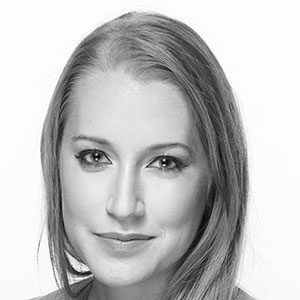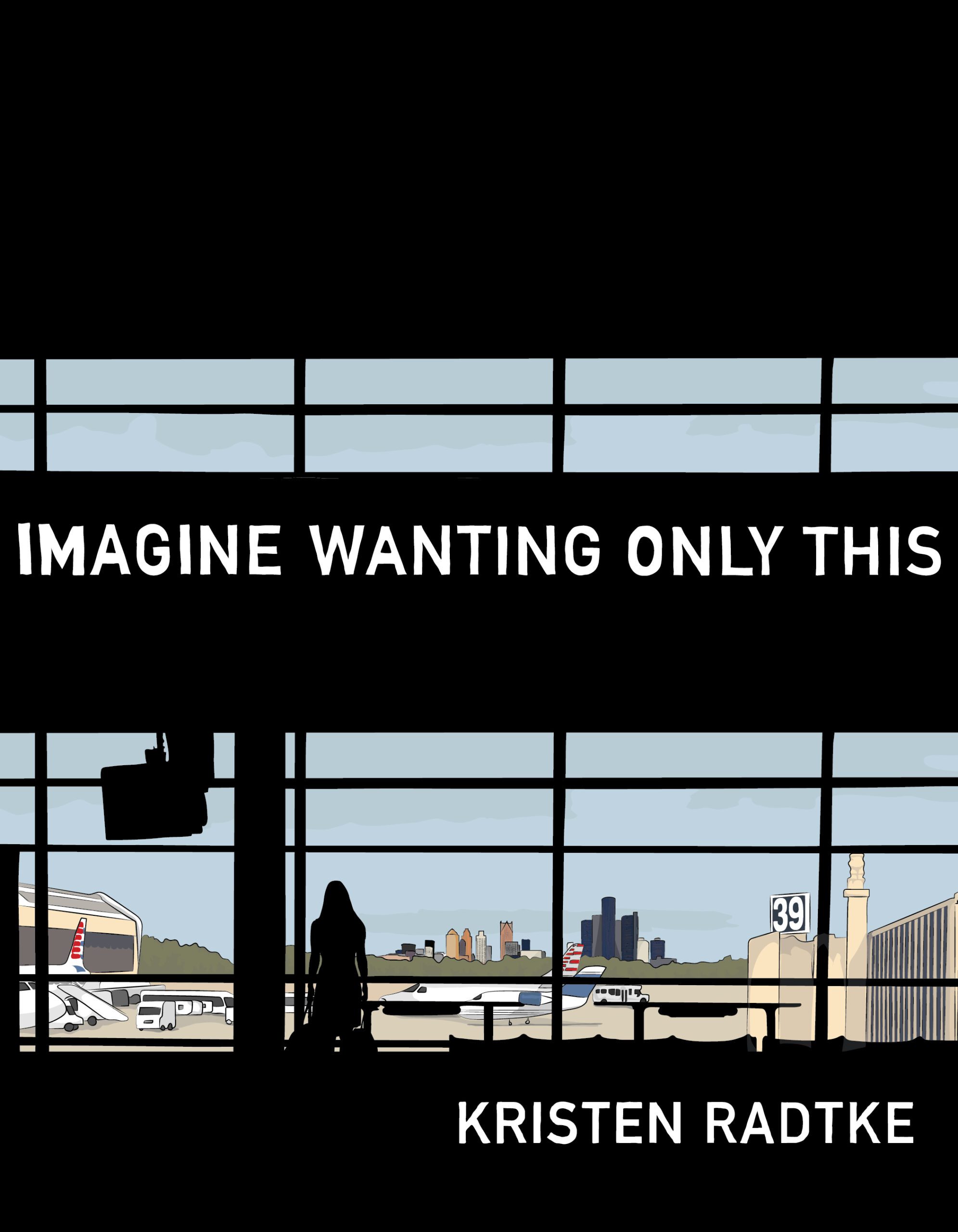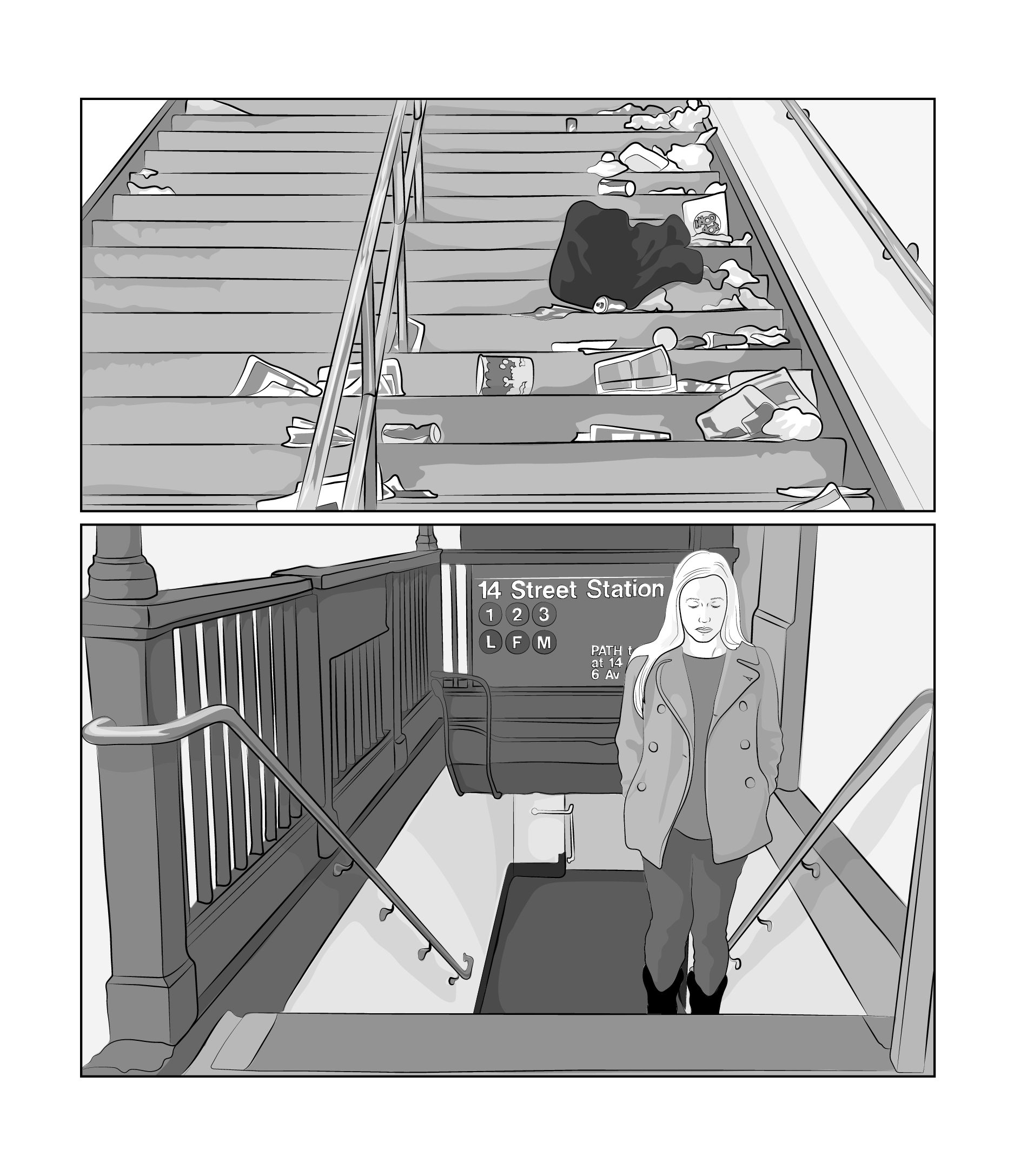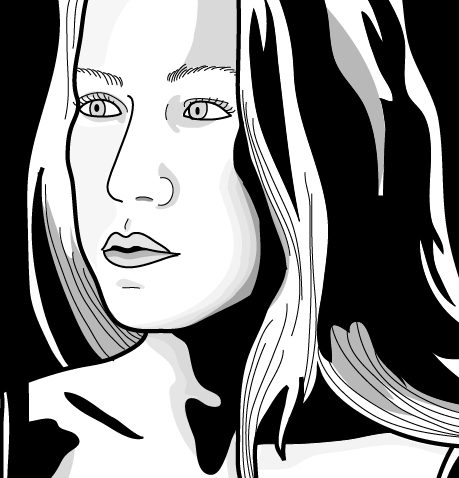
Complex and intriguing narratives are embedded into Kristen Radtke’s graphic (as in illustrated) memoir, Imagine Wanting Only This. A writer and illustrator with a MFA from the University of Iowa’s Nonfiction Writing Program, Radtke’s literary debut deserves to sit alongside other popular contemporary memoirs like H Is for Hawk, The Faraway Nearby, and The Empathy Exams. Her compelling visual transmedia storytelling creates intimacy and narrative through the relationship between text and image, which she uses to depict vast emotions, symbolism, thematic impulses, and flashbacks.
Radtke has been working on this book her whole life. It begins with a tender prologue addressed to a beloved uncle from her younger self. The death of Radtke’s uncle from a rare heart disease coincides with her first visit to an abandoned city while she was in college. After this, ruins of abandoned cities, boarded up mining towns and volcano-covered villages become her obsession, a global pursuit for a contemplative journeyer. Her concern with rot and decay is driven by an inward philosophical and spiritual impulse seeded through a maze of grief that unfolds over time.
Radtke’s post-apocalyptic insights exist in the liminal territory of ruins and death; we can preserve or destroy what we have left. Her intrigue traces back to a statement she made in an interview with Mary Selph for Blackbird in 2013: “We want—and don’t want—to know what things will look like when we’re gone.” More recently, in Creating Nonfiction: Twenty Essays and Interviews with the Writers, Radtke expanded on the subject: “We see ourselves in ruins, too, particularly modern ones. Ruins that look like lives we recognize are terrifying because it’s proof of how vulnerable we all are, right now.”
On a beatific September day I took the subway from Manhattan to East Flatbush to visit Radtke. Above ground I walked to her pre-war building and entered a lobby built in 1928. Architecture from a time when artistic attention was paid to ornate ceilings and intricate moldings echoed nostalgia, loss and potential—a perfect place for Radtke.
We’re not close friends, just fellow ruin-lusters like Shakespeare, Marlowe, Virginia Woolf, and Rose Macaulay. Our obsession serves us as we wander through and gaze upon wreckage in search of connections, truths, and mythologies. At fifteen, the death of my older brother changed the course of my life. It colored how I interacted with the world and made me clutch to a quest that explores permanence, a passion I share with Radtke.
Kristen Radtke is the Managing Editor of Sarabande Books and the Film Editor of TriQuarterly magazine. For info on her book tour visit her website.
***
The Rumpus: Tell me how this book was started. Did illustrations come before text?
Kristen Radtke: When I began a very early draft of the book, I wrote the prose first, storyboarded it, and then drew all the images. It was the only way I knew how to get something on the page, and I needed to do it that way—but then I also needed to completely rewrite and redraw nearly the entire thing. When I got more comfortable with the project, I started working between the illustrations and the text, expanding scenes through drawings, and cutting text that I could convey through image.
Rumpus: Had you always been able to draw?
Radtke: I got my fair share of Ds in high school math classes because I was always drawing in the back of the room instead of paying attention. Art classes were probably the only reason I graduated. I was just in awe of the way something could begin to appear and take shape in front of me. It felt very private, and I loved that.
Rumpus: Prior to attending Iowa’s Nonfiction Writing Program had you thought about pursuing illustrated essays or was that inspired by John Bresland’s workshop? [Bresland, former Film Editor at TriQuarterly Review, and a video essayist, teaches creative writing and filmmaking at Northwestern University.]
Radtke: I’d played around a little bit with illustrated essays in the first years of graduate school, but only in very limited ways—a ratio of one drawing to a full page of text, for example. I didn’t begin using the comics/graphic novel form until my last semester, and even then only in small doses. I was still mostly writing prose, and then I’d draw a few panels then switch back. I’d been drawing my whole life, but never scene after scene, with the burden of creating recognizable characters and settings over and over again. Most of my resistance to the form was that I simply didn’t think I could do it, or even sustain a drawing style for longer than a few pages. It was such a slow, arduous process.
At a certain point I just became more interested in mixing writing with something visual, and graduate school seemed like a safe space to try something that might in the end be a complete and utter waste of time. I remember my friends making fun of me when I told them I was working on drawings instead of essays because they thought it was a preposterous thing to do within the confines of a writing program. That isn’t to say that they were wrong, or that the drawings I did during that time were any good—they weren’t. But it was a start.
Rumpus: Does storyboarding provide structure, scaffolding? If so, how does that structure/scaffolding change from project to project?
Radtke: Yes, exactly—storyboarding is a kind of scaffolding. It gets me past that blank-page anxiety so I can start building. I can’t say that I totally know how that process changes from project to project since I’m only in the early stages of my second book-length project, but I can say that a finished work is often unrecognizable from what I storyboarded or envisioned before I began. All art probably works like that in some way.
Rumpus: What’s the editorial process like for a graphic novel? Does it differ from the prose editorial process?
Radtke: There are similarities in the process. Good editors should respond to drawings with the same kind of attention with which they’d respond to text. I love an editor or reader who will notice things like “the nightstand moved from the left side of the bed on page 14 to the right side on page 17!” or “he was wearing a short-sleeved shirt in this panel, and now he’s wearing a sweater.” It’s amazing how things like that can become invisible to the person making them—or at least they sometimes become invisible to me.
Rumpus: There’s a level of subjectivity attached to visual components of a graphic novel that could be challenging to an editor if he or she isn’t familiar with elements and tools of illustrated storytelling. Have you had challenges with editors not familiar with the genre? Can you share a time that an editor helped you through a graphic-narrative obstacle by providing constructive feedback that allowed you to re-edit or pursue a different narrative illustration?
Radtke: I think there’s definitely subjectivity in the way editors respond to visual components of a graphic novel, but that’s the case for prose novels, too. Illustrations have a voice and a style just like sentences do, and everyone is going to respond differently to that. I think sometimes editors who aren’t very familiar with graphic narratives don’t always take them seriously, and sometimes don’t see comics as literature. Which is fine. It’s not for everyone.
Rumpus: What’s your biggest concern with editors and your work?
Radtke: Maybe I’d say the challenge is that they’re not as critical of the form because they’re excited to see something different and say, “Great, we’ll run it.” And, I appreciate their excitement over a new style. But I think that you have to be as critical of the graphic stuff as you are of prose.
Rumpus: Could you elaborate on the connection between the death of your uncle and architectural ruins?
Radtke: I was a sophomore in college, and it was either a coincidence or a trigger—I’m not sure—but my uncle’s death coincided with my first visit to an abandoned city. And from there, those things felt very intertwined—like the idea of a heart defect, the idea of a heart kind of collapsing on itself, the idea of a building or a city collapsing in on itself…
The first city I went to was Gary, Indiana. I was going to school in Chicago, and it was about twenty minutes away. In the book I make it seem, and it was, very cavalier, flip, like we’re art students, let’s go do this weird thing. I didn’t really understand the implications of tromping around an abandoned city. I certainly didn’t understand the socioeconomic or racial implications of a place like Gary at the time when I was nineteen. But that awareness and narrative lens was developed as I became more interested in abandoned cities.
Rumpus: Can you expand on the socioeconomics of a place like Gary?
Radtke: I showed up to a place with almost no understanding of its history or the hardships it had faced and walked through it like a tourist expecting to leave with a few snapshots and a story. That’s absolutely the wrong way to approach any place that isn’t yours, especially one like Gary, a city that belongs to a lot of people who’ve been disenfranchised.
Rumpus: Writing a narration that spans childhood to adulthood, what were the challenges you faced as the protagonist of a graphic book?
Radtke: I got really nervous about how many times could I draw myself before it got ridiculous. [Laughs]
Rumpus: As the narrator how did you push past feeling self-conscious? Did knowing that a graphic book relies on repeated images for immediate visual recall of characters and places put that into perspective?
Radtke: I tried not to think about it, I guess. You know, all kinds of anxiety can come up that you have to just push out of your brain or you can’t do it. It’s the same thing with worrying about what my family would think about my book. You know, you just had to do it.
[Radtke gestures toward her computer screen, where she’s pulled up images from her book. Morgan, her Maine Coon cat, slides between us hoping that the pages where he appears will pop up.]
This is me in middle school, then high school. Here I’m going to college. It was hard making the transitions of aging. I was just like, okay, maybe I’ll make my cheeks a little bit bigger in high school—back then you have a bit more baby fat, stuff like that. It was tricky because it all took place within a short period of time. You don’t want to rely just on hairstyle or clothing. Changing and altering the narrative text via captions, thought or dialogue balloons is also a transitional tool available to me in developing my characters. Even the space between images and texts conveys a movement of time within the story.
Rumpus: How did you decide when to use images instead of text to move your story forward? Do images hold more intimacy and emotional weight for you over text?
Radtke: It really depends on the scene. Sometimes I can see clearly what I want to draw and the way I want a moment to unfold visually. Then I work the text around that. Other times I write before I’ve figured out what needs to be represented visually. But I like working best—and I think the results are better—when I’m moving back and forth between the two, seeing how they can come together. As far as images and their emotional weight over text, for me its more the fact that drawing is so arduous and can take an enormous amount of time. Many of those hours are spent in early the stages where the image doesn’t even look like anything yet. It’s almost always a surprise to me when it comes together.
Rumpus: Did the material ever suggest to you that a particular scene was better served by an image over text? What does the space between image and text convey? Is it movement of time? Shifting of emotion? Reflective pause?
Radtke: Not necessarily, although generally if I can draw it, that’s what I do. The text got lighter and lighter in each draft of Imagine Wanting Only This. It’s just a matter of aesthetic preference, but I think big chunks of text can be clunky in graphic work (which isn’t to say there aren’t chapters in this book that don’t include big chunks of text–it’s often the most economical option).
Regarding space between image and text, it’s different every time. I think that space can convey a multitude of things depending on how it’s employed. If the relationship between text and image doesn’t vary or grow or change, I don’t think I’m doing my job.
Rumpus: When readers see images versus text, are there cues for them about how to read and navigate your story?
Radtke: I’m not sure. The standard comics rule is that you read panels left to right, top to bottom. But I think it’s up to a reader whether they want to engage with text or image first.
Rumpus: When you tackled a complex issue in your book—heartbreak, decay and connection, for example—did visual narrative provide you with greater freedom to explore deeper truths?
Radtke: It provided me with an additional mode with which to explore and convey these issues, which I suppose can be freeing. When I feel stuck in one mode I can move to another.
Rumpus: Is there anyone currently who influences your work and artistic vision?
Radtke: I’m a big fan of Tom Hart and Richard McGuire, and I probably wouldn’t have started drawing comics if it wasn’t for the work of Adrian Tomine and Alison Bechdel.
Rumpus: How many rounds of edits did your manuscript go through?
Radtke: That’s a good question. I don’t really know. They bought the book on two chapters. Then I had to make an outline, draw and write the rest of it and I sent all that in at the beginning of this year, maybe January or February of 2016—so probably two or three rounds since then.
Rumpus: Was there a particular editor that you wanted to work with at Pantheon Books? If so, who and why?
Radtke: I was ready to throw the book away when Dan Frank, the Editor-in-Chief of Pantheon, read it—and, quite frankly, saved it. He knew exactly what the project needed. I’ve never met anyone who broke things open for me so clearly before. I’ve also been hugely lucky to work closely with Tim O’Connell, a brilliant editor who was so present during the making of this book, and the gracious recipient of so many panicked and annoying emails from me, that he should probably get a co-author credit.
Rumpus: Why Pantheon Books over another publisher for Imagine Wanting Only This? What made it feel like the right publishing fit?
Radtke: There isn’t a better publisher of literary graphic novels in America than Pantheon. Chris Ware, Art Spiegelman, Marjane Satrapi, Richard McGuire, Charles Burns—so many of my favorite graphic novelists found homes with them. They make truly beautiful books. They make my work look better.
Rumpus: Do you have a mentor?
Radtke: I worked with incredible teachers at Iowa, and my cohort was full of some of the best young writers in the country—I was immensely lucky to be working among them. I started working on the book under the direction of Robin Hemley, who encouraged me to draw in the first place, and John D’Agata. Both professors were indispensable to me at the early stages of the project.
Rumpus: What are your writing habits? Is there anything you find helpful to do when you’re stuck in a particular place in your work?
Radtke: My working habits are basically that I work every possible moment that I can. Drawing is simply such a time-consuming process that the only way to make a whole book (for me, anyway) was to just be relentless. The benefit of working between writing and drawing is that when you’re stuck or bored with one medium you can move to the other. But in general I don’t believe in writer’s block. I think you just have to sit and sit and make it happen, which means saying no to a lot of things you’d rather be doing. You just have to do the work.
Rumpus: What are you currently reading? What online journals or literary websites do you most often read?
Radtke: Two books by amazing women everyone should look out for Don’t Come Back by Lina Maria Ferreira Cabeza-Vanegas, just released by Mad River, and Mira Jacob’s graphic memoir Good Talk: Conversations I’m Still Confused About, forthcoming from Dial Press in 2018. I love reading artist and writer Sophie Lucido Johnson’s great website, as well.








